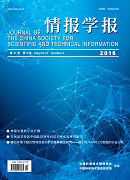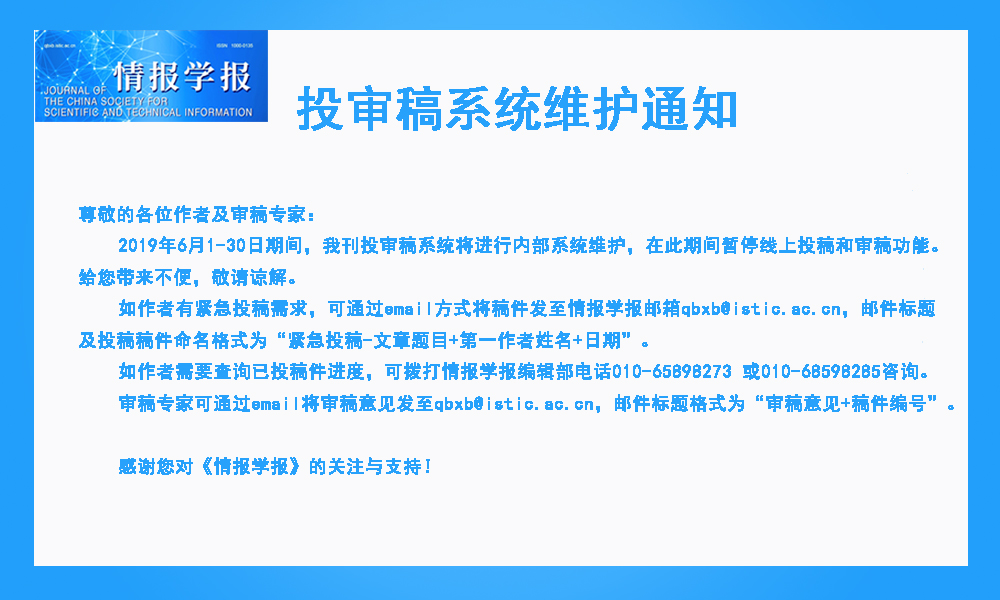 |
|
2018 Vol. 37, No. 4
Published: 2018-04-24 |
|
|
| |
|
|
|
|
|
341 |
The Diffusion of Citations for Individual Publications |
|
 |
Min Chao, Ding Ying, Li Jiang, Sun Jianjun |
|
|
DOI: 10.3772/j.issn.1000-0135.2018.04.001 |
|
|
Citation is an important connection that links scientific knowledge, providing us with a key to understanding the acquisition, communication, transformation, and innovation of knowledge. Citations are not only static statistic distributions, but also dynamic growth processes in the complex system of modern scientific communication. Considering citation as a diffusion process, this paper reconsiders the essential elements, quantification metrics, and growth mechanisms of this process from multiple approaches. The citation diffusion system involves at least these elements: time environment, time of first citation, citation peak, total citation counts, citation rate, citation lifecycle, literature network/ecosystem, and citation “takeoff”. As a diffusion unit on the micro scale, citation cascade evolves from the two dimensions of cascade virality and cascade popularity, exhibiting two typical patterns of broadcast diffusion and viral diffusion. The huge diversity of diffusion patterns stems from the underlying mechanisms that govern citation diffusion, which may include preferential attachment, aging, fitness, as well as innovation and imitation mechanisms. Further exploration of citation diffusion and its mechanisms will not only enhance our understanding of this process, but also help reveal its potential value in such scientific activities as research evaluation, scientific prediction, and scientific policy-making. |
|
|
2018 Vol. 37 (4): 341-350
[Abstract]
(
318
)
HTML
(1 KB)
PDF
(2621 KB)
(
1135
) |
|
|
|
362 |
An Empirical Study on Privacy Policy Reading Intention of Social Media Users |
|
 |
Zhu Hou, Zhang Mingxin, Lu Yonghe |
|
|
DOI: 10.3772/j.issn.1000-0135.2018.04.003 |
|
|
Privacy policies are sets of terms that inform users of how their personal information is collected and utilized by social media platforms. However, in the actual process, users rarely or never read privacy policies. In explaining this phenomenon, suggestions are made for the formulation and improvement of privacy policies and the protection of users’ personal information. Based on the relevant literature at home and abroad, subjective norms, motivation, reading ability, content integrity, and readability are introduced. The structural equation model is used to test the hypothesis on 344 samples. On the basis of the test results, the content integrity and readability of seven widely used social media privacy policies are analyzed. Subjective norms, motivation, readability, content integrity, and readability all have positive effects on users’ reading intentions. Privacy policies characterized by specific content, transparency, and reasonable length will have higher reading rates. |
|
|
2018 Vol. 37 (4): 362-371
[Abstract]
(
403
)
HTML
(1 KB)
PDF
(427 KB)
(
1600
) |
|
|
|
384 |
Study of a Group Recommendation Model of Integrating Context Information in a Mobile Environment—Empirical Analysis Based on User APP Behavior Data |
|
 |
Xia Lixin, Yang Jinqing, Cheng Xiufeng |
|
|
DOI: 10.3772/j.issn.1000-0135.2018.04.005 |
|
|
In order to improve the accuracy of recommended results in the group recommendation model, a group recommendation model integrating context information is proposed in this paper. Firstly, the user behavior context data are obtained, and the preference represented by individual user behavior is extracted. Secondly, the behavior similarity of individual users is calculated and cluster discovery is conducted. Subsequently, the group behavior characteristics are mined from context data, and then a feature vector of group behavioral preference is built. Finally, collaborative recommendation ideas are combined for the group as a whole. The collaboration also occurs with other groups producing an item history score to form a prediction score. In the experiment, we analyze the user’s operation flow, extract the theme sequence features, and then incorporate the classic context information to produce the recommendation results. The results show that the top-6 of the recommended results obtained by using this model are more accurate than those recommended by traditional (non-situational) groups. Therefore, this model is more suitable for group recommendations in mobile environments. |
|
|
2018 Vol. 37 (4): 384-393
[Abstract]
(
191
)
HTML
(1 KB)
PDF
(1124 KB)
(
915
) |
|
|
|
406 |
Text Mining on the Government Work Reports of the State Council (1954-2017) and Social Transformation Research |
|
 |
Wei Wei, Guo Chonghui, Chen Jingfeng |
|
|
DOI: 10.3772/j.issn.1000-0135.2018.04.007 |
|
|
The government work report of the State Council is a comprehensive policy text. This paper uses text mining technology to carry out a comprehensive multi-granularity, multi-level quantitative analysis of the government work reports. This has immense practical significance for acquiring an understanding of the evolution of domain content and the laws of social transformation discovery to relevant personnel. Firstly, a series of text preprocessing is done by using the Chinese word segmentation tool combined with three kinds of dictionaries created by us: the domain dictionary, the stop word dictionary, and the thesaurus dictionary. Then, frequent words, hot words, and new words are redefined and three kinds of corresponding feature mining methods are proposed. A quantitative calculation method for social vitality is proposed based on these new words, and then clustering analysis is conducted for feature words represented by a time series with a popular clustering method. According to the document information of the government work reports, we divide the time period from 1954 to 2017 into different stages, using which we conduct the pattern discovery for feature words combined with the feature words clustering results. Finally, our findings show that the selected frequent words, hot words, and new words in the government work reports can indicate the common problems, the hot issues and its evolution pattern, and the changes in social activity over the years. From the term clustering results and the reasonable time stages of the whole period, we get nine specific patterns of feature words. |
|
|
2018 Vol. 37 (4): 406-421
[Abstract]
(
373
)
HTML
(1 KB)
PDF
(2062 KB)
(
1602
) |
|
|
|
422 |
A Review of the Cross-Modal Retrieval Model and Feature Extraction Based on Representation Learning |
|
 |
Li Zhiyi, Huang Zifeng, Xu Xiaomian |
|
|
DOI: 10.3772/j.issn.1000-0135.2018.04.008 |
|
|
Representation learning, particularly deep learning, has received wide attention and seen application in speech recognition, image analysis, and natural language processing fields. It not only promotes the research and development of artificial intelligence, but urges enterprises to consider new business and profit models. This paper aims to examine these studies in the form of reviews, and ultimately form a complete overview of the topic. Through the investigation and organization of relevant literature locally and internationally, this paper summarizes the research results of cross-modal retrieval and feature extraction based on representation learning from the two dimensions of information extraction and representation, and cross-modal system modeling. The main research includes summarizing five traditional representation learning algorithms, which are the autoencoder, sparse encoding, the restricted Boltzmann machine, deep belief networks, and convolutional neural networks. From the shared layer relationship between each mode, the representation space, and the correlation between each mode’s in-depth learning-based cross-modal modeling algorithm, the present state of research on modeling systems based on cross- modal modeling is summed up. Finally, the evaluation index of cross-modal retrieval is summarized. The study finds that the existing retrieval research is rich in single-modal information retrieval and that the content of queries and candidate sets belong to the same modality, whereas cross-modal retrieval is limited to two modal alignment languages of images and texts. Future research needs to see an increase of modal retrieval of audio, video, images, text, and other multimodal data, and using deeper constructing multimodal retrieval models and feature extraction algorithms to achieve three-or- greater cross-modal retrieval. In addition, an evaluation index of multimodal retrieval systems must be established. |
|
|
2018 Vol. 37 (4): 422-435
[Abstract]
(
322
)
HTML
(1 KB)
PDF
(841 KB)
(
3362
) |
|
|
|
436 |
Review of Clickstream Data Analysis and Visualization Studies |
|
 |
Jiang Tingting, Xu Yaping, Guo Qian |
|
|
DOI: 10.3772/j.issn.1000-0135.2018.04.009 |
|
|
This review provides an overview of studies on clickstream data analysis and visualization performed between 2000 and 2017. In-depth analysis and comparisons have been performed on the visual characteristics of visualization studies available in literature. The analysis reveals that the existing visualizations (1) usually involve users’ visiting footprints, movements, and pathways as components of representation, (2) present them as directed graphs, sequence diagrams, line graphs, network graphs, cloud maps, Sankey diagrams, matrix graphs, stack graphs, and multiply graphs, and (3) support user interaction through features such as overview, zoom, filter, details-on-demand, relate, history, and extract. This review suggests that future studies should focus on the application of big data technologies in clickstream data analysis, visualization of mobile clickstream data, and user testing for visualization evaluation. |
|
|
2018 Vol. 37 (4): 436-450
[Abstract]
(
227
)
HTML
(1 KB)
PDF
(3485 KB)
(
1214
) |
|
|
|


